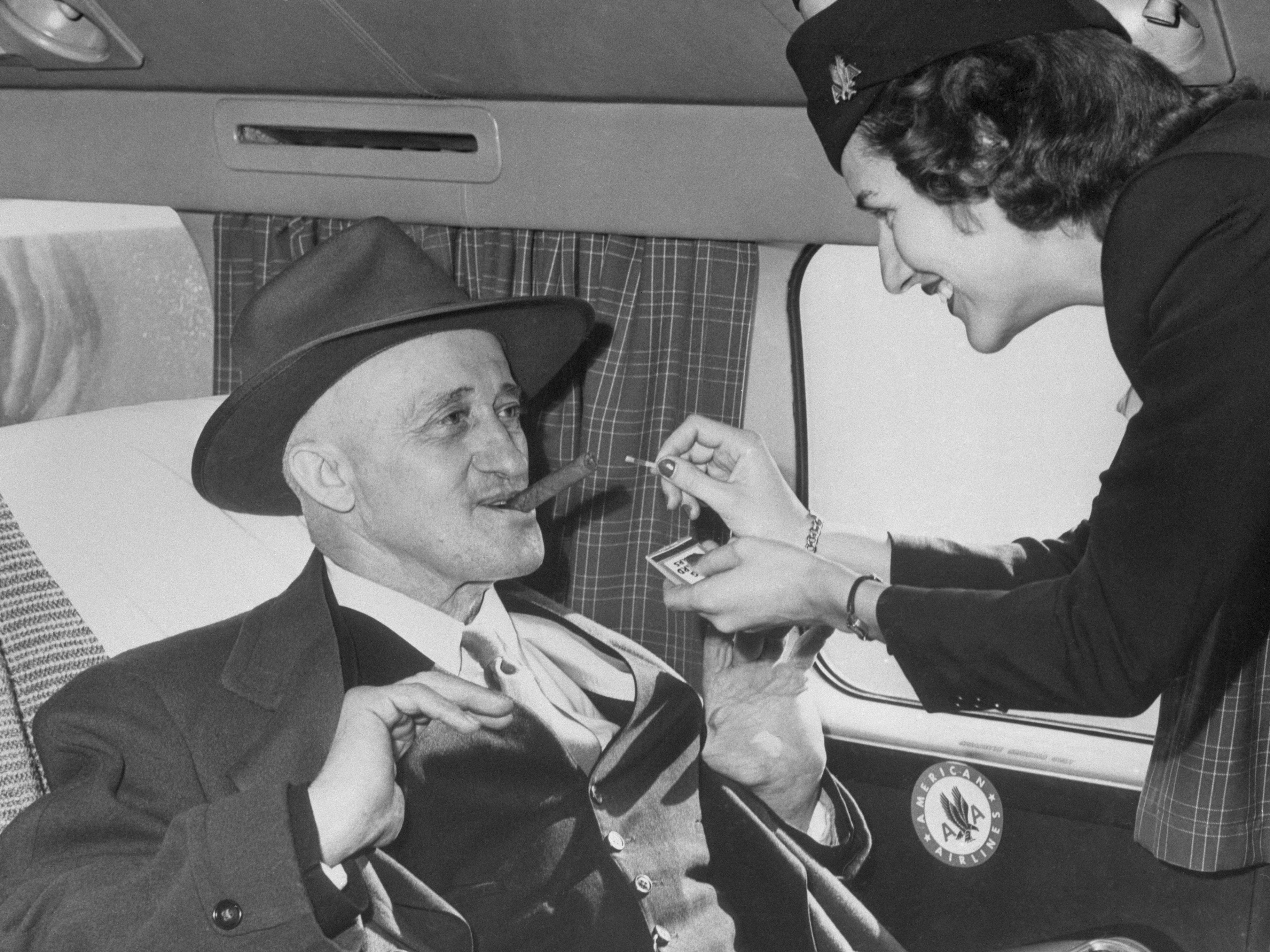- Smoking and airplanes once went hand in hand but the practice is now largely banned the world over.
- US government regulations on smoking on airplanes first began in the 1970s and culminated in smoking being banned on all flights touching US territory.
- China most recently banned smoking on its planes in 2016 and later eliminated an exception that allowed pilots to smoke in the cockpit.
- Visit Business Insider’s homepage for more stories.
“Smoking or non-smoking?” That question used to be asked of travelers when booking a seat on an airplane in the US from the 1970s until 2000 when smoking on airplanes was fully banned by the federal government.
In the early days of air travel, smoking on an aircraft was as common as ordering a drink, especially in the onboard lounges of grand aircraft like the Boeing 747.
As the science on smoking became more clear and society moved away from the practice, aircraft became one of the main targets for prohibition. Slowly but surely, airlines and governments took action and incrementally restricted what was once a freely acceptable activity on an airplane.
With passengers around the world becoming increasingly averse to smoke-filled cabins, however, the option to smoke on an airplane became scarcer and airlines started to go smoke-free despite alienating a segment of their customer base.
It wasn't until 2000 that the US banned smoking on all flights to, from, or within the US. Now, it's nearly impossible to travel on an aircraft that allows smoking.
Take a look a back at the history of smoking on airplanes and how it took 23 years to eliminate the practice from US skies.
Smoking on airplanes dates back to the start of air travel, a time when smoking was a societal norm.

In the luxurious aircraft cabins of the past, smoking was no more unusual than having a drink or meal.

With nearly half of the population admitted smokers, the practice was a common affair and quickly found its way to the skies.

Source: Population Reference Bureau
It wasn't until 1973 that the government stepped in to regulate smoking in the air by mandating smoking and non-smoking sections of an aircraft.

Source: US Government
The first-ever prohibition on tobacco smoking on aircraft came in 1977 when the US Civil Aeronautics Board banned cigar and pipe smoking on airplanes.

Source: New York Times
Though it was a landmark victory for anti-smokers and their advocacy groups, it wouldn't be for another 23 years that smoking on planes would be banned outright in the US.

The next steps came in increments, with the Civil Aeronautics Board then prohibiting smoking of all forms on planes with 30 seats or less in 1984.

Source: Washington Post
Restrictions would be placed on certain flights, based primarily on seat count and duration, with the Civil Aeronautics Board voting to ban smoking on flights less than two hours in duration.

Source: New York Times
The vote was later reversed the same day when the chairman of the Civil Aeronautics Board changed his mind on the matter but the ban was later brought back to life via a congressional bill that President Reagan signed into law in 1988.

Source: Forbes
Some airlines joined in, with Northwest Airlines banning smoking on all of its domestic flights.

Source: Forbes
Outside the US, airlines such as Japan Airlines, All Nippon Airways, and Scandinavian Airlines began implementing bans on domestic flights, starting the global trend against in-flight smoking.

Source: Scandinavian Travelers and Aviation Week
President HW Bush later expanded the ban to nearly all domestic flights except for certain flights over six hours in 1990.

Source: Forbes
Pilots, however, were still allowed to smoke, with regulators fearing the effects of a pilot going through withdrawals while flying.

Source: New York Times
Delta Air Lines banned smoking on all of its flights worldwide in 1995, the first global US airline to do so.

Source: New York Times
Later that year, the US, Canada, and Australia signed an agreement banning smoking on flights between the three countries.

Source: New York Times
In 1997, the European Union issued a ban on all flights in member states, affected flights within and between 14 countries across the continent.

Source: Scandinavian Traveler
The final nail in the coffin for smoking on flights to, from, or within the US came in 2000 with President Clinton signing in the Wendell H. Ford Aviation Investment and Reform Act for the 21st Century.

Source: US Government
The legacy of in-flight smoking can still be seen today on every aircraft flying as they are required to have ashtrays onboard.

Despite the prohibition, the ashtray requirement prevents those who disobey the rule from accidentally starting a fire by putting their butts out in a toilet tissue filled trash can rather than an ashtray.

A holdover from earlier times, some older aircraft that are still flying feature ashtrays in the armrests of seats.

Following the US ban, most countries around the world have followed suit, though some had taken longer than others. China didn't ban smoking onboard airplanes until 2017, with an exception for pilots remaining in effect until 2019.

Source: Skift
The US didn't stop at cigarettes. Its attention eventually turned to electronic cigarettes, which were banned from being used onboard airplanes in 2016.

Source: New York Times
During every safety briefing, flight attendants will warn about the consequences of smoking on an airplane but that doesn't stop everyone.

Unlike flying in the past, smoking on an airplane nowadays includes hefty fines and a visit from airport police upon arrival.
The era of smoke-filled airplane cabins is long gone and not likely to return anytime soon.
Some charter aircraft allow smoking, but the lingering stench is unappealing to aircraft owners and other flyers, making it a rarity even then.
The closest most can get to an airplane when lighting up a cigarette is either at the terminal sidewalk or in designated smoking lounges at airports.

